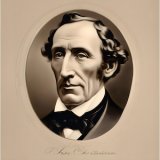The Fir Tree
"The Fir Tree" by Hans Christian Andersen is a classic children's tale that centers around a small fir tree in the forest who dreams of growing up. The tree wishes to become grand and tall like its peers. Throughout different seasons and with every different group of visitors to the forest, the tree learns more about life and its own existence. When it is finally cut down and decorated for Christmas, it continues to dream of better days ahead, only to eventually realise its precious past moments in the forest. This poignant tale illustrates Andersen's unique ability to write a deeply insightful narrative cloaked in a simple children's story form.
Far down in the forest, where the warm sun and the fresh air made a sweet resting-place, grew a pretty little fir-tree; and yet it was not happy, it wished so much to be tall like its companions--the pines and firs which grew around it. The sun shone, and the soft air fluttered its leaves, and the little peasant children passed by, prattling merrily, but the fir-tree heeded them not. Sometimes the children would bring a large basket of raspberries or strawberries, wreathed on a straw, and seat themselves near the fir-tree, and say, "Is it not a pretty little tree?" which made it feel more unhappy than before. And yet all this while the tree grew a notch or joint taller every year; for by the number of joints in the stem of a fir-tree we can discover its age. Still, as it grew, it complained, "Oh! how I wish I were as tall as the other trees, then I would spread out my branches on every side, and my top would over-look the wide world. I should have the birds building their nests on my boughs, and when the wind blew, I should bow with stately dignity like my tall companions." The tree was so discontented, that it took no pleasure in the warm sunshine, the birds, or the rosy clouds that floated over it morning and evening. Sometimes, in winter, when the snow lay white and glittering on the ground, a hare would come springing along, and jump right over the little tree; and then how mortified it would feel! Two winters passed, and when the third arrived, the tree had grown so tall that the hare was obliged to run round it. Yet it remained unsatisfied, and would exclaim, "Oh, if I could but keep on growing tall and old! There is nothing else worth caring for in the world!" In the autumn, as usual, the wood-cutters came and cut down several of the tallest trees, and the young fir-tree, which was now grown to its full height, shuddered as the noble trees fell to the earth with a crash. After the branches were lopped off, the trunks looked so slender and bare, that they could scarcely be recognized. Then they were placed upon wagons, and drawn by horses out of the forest. "Where were they going? What would become of them?" The young fir-tree wished very much to know; so in the spring, when the swallows and the storks came, it asked, "Do you know where those trees were taken? Did you meet them?" The swallows knew nothing, but the stork, after a little reflection, nodded his head, and said, "Yes, I think I do. I met several new ships when I flew from Egypt, and they had fine masts that smelt like fir. I think these must have been the trees; I assure you they were stately, very stately." "Oh, how I wish I were tall enough to go on the sea," said the fir-tree. "What is the sea, and what does it look like?" "It would take too much time to explain," said the stork, flying quickly away. "Rejoice in thy youth," said the sunbeam; "rejoice in thy fresh growth, and the young life that is in thee." And the wind kissed the tree, and the dew watered it with tears; but the fir-tree regarded them not. Christmas-time drew near, and many young trees were cut down, some even smaller and younger than the fir-tree who enjoyed neither rest nor peace with longing to leave its forest home. These young trees, which were chosen for their beauty, kept their branches, and were also laid on wagons and drawn by horses out of the forest. "Where are they going?" asked the fir-tree. "They are not taller than I am: indeed, one is much less; and why are the branches not cut off? Where are they going?" "We know, we know," sang the sparrows; "we have looked in at the windows of the houses in the town, and we know what is done with them. They are dressed up in the most splendid manner. We have seen them standing in the middle of a warm room, and adorned with all sorts of beautiful things,--honey cakes, gilded apples, playthings, and many hundreds of wax tapers." "And then," asked the fir-tree, trembling through all its branches, "and then what happens?" "We did not see any more," said the sparrows; "but this was enough for us." "I wonder whether anything so brilliant will ever happen to me," thought the fir-tree. "It would be much better than crossing the sea. I long for it almost with pain. Oh! when will Christmas be here? I am now as tall and well grown as those which were taken away last year. Oh! that I were now laid on the wagon, or standing in the warm room, with all that brightness and splendor around me! Something better and more beautiful is to come after, or the trees would not be so decked out. Yes, what follows will be grander and more splendid. What can it be? I am weary with longing. I scarcely know how I feel." "Rejoice with us," said the air and the sunlight. "Enjoy thine own bright life in the fresh air." But the tree would not rejoice, though it grew taller every day; and, winter and summer, its dark-green foliage might be seen in the forest, while passers by would say, "What a beautiful tree!" A short time before Christmas, the discontented fir-tree was the first to fall. As the axe cut through the stem, and divided the pith, the tree fell with a groan to the earth, conscious of pain and faintness, and forgetting all its anticipations of happiness, in sorrow at leaving its home in the forest. It knew that it should never again see its dear old companions, the trees, nor the little bushes and many-colored flowers that had grown by its side; perhaps not even the birds. Neither was the journey at all pleasant. The tree first recovered itself while being unpacked in the courtyard of a house, with several other trees; and it heard a man say, "We only want one, and this is the prettiest." Then came two servants in grand livery, and carried the fir-tree into a large and beautiful apartment. On the walls hung pictures, and near the great stove stood great china vases, with lions on the lids. There were rocking chairs, silken sofas, large tables, covered with pictures, books, and playthings, worth a great deal of money,--at least, the children said so. Then the fir-tree was placed in a large tub, full of sand; but green baize hung all around it, so that no one could see it was a tub, and it stood on a very handsome carpet. How the fir-tree trembled! "What was going to happen to him now?" Some young ladies came, and the servants helped them to adorn the tree. On one branch they hung little bags cut out of colored paper, and each bag was filled with sweetmeats; from other branches hung gilded apples and walnuts, as if they had grown there; and above, and all round, were hundreds of red, blue, and white tapers, which were fastened on the branches. Dolls, exactly like real babies, were placed under the green leaves,--the tree had never seen such things before,--and at the very top was fastened a glittering star, made of tinsel. Oh, it was very beautiful! "This evening," they all exclaimed, "how bright it will be!" "Oh, that the evening were come," thought the tree, "and the tapers lighted! then I shall know what else is going to happen. Will the
Translation
Translate and read this book in other languages:
Select another language:
- - Select -
- 简体中文 (Chinese - Simplified)
- 繁體中文 (Chinese - Traditional)
- Español (Spanish)
- Esperanto (Esperanto)
- 日本語 (Japanese)
- Português (Portuguese)
- Deutsch (German)
- العربية (Arabic)
- Français (French)
- Русский (Russian)
- ಕನ್ನಡ (Kannada)
- 한국어 (Korean)
- עברית (Hebrew)
- Gaeilge (Irish)
- Українська (Ukrainian)
- اردو (Urdu)
- Magyar (Hungarian)
- मानक हिन्दी (Hindi)
- Indonesia (Indonesian)
- Italiano (Italian)
- தமிழ் (Tamil)
- Türkçe (Turkish)
- తెలుగు (Telugu)
- ภาษาไทย (Thai)
- Tiếng Việt (Vietnamese)
- Čeština (Czech)
- Polski (Polish)
- Bahasa Indonesia (Indonesian)
- Românește (Romanian)
- Nederlands (Dutch)
- Ελληνικά (Greek)
- Latinum (Latin)
- Svenska (Swedish)
- Dansk (Danish)
- Suomi (Finnish)
- فارسی (Persian)
- ייִדיש (Yiddish)
- հայերեն (Armenian)
- Norsk (Norwegian)
- English (English)
Citation
Use the citation below to add this book to your bibliography:
Style:MLAChicagoAPA
"The Fir Tree Books." Literature.com. STANDS4 LLC, 2025. Web. 22 Jan. 2025. <https://www.literature.com/book/the_fir_tree_2165>.




Discuss this The Fir Tree book with the community:
Report Comment
We're doing our best to make sure our content is useful, accurate and safe.
If by any chance you spot an inappropriate comment while navigating through our website please use this form to let us know, and we'll take care of it shortly.
Attachment
You need to be logged in to favorite.
Log In